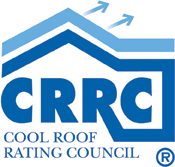This CE Center article is no longer eligible for receiving credits.
Imagine specifying a roof that is visually dynamic, yet also reduces cooling energy loads by 30 percent, combats global warming, and decreases roof maintenance costs. This miracle roof can meet all your expectations for comfort, cost and aesthetics and it is not some product from the future-it is a cool roof. Technological advancements and ecological awareness have evolved cool roof materials from the flat, white roofs of yesterday to the myriad colors, materials, and profiles of today. Because they are so versatile, cool roofs can be applied to all styles of projects, from pitched residential to flat commercial roofs. Innovative technologies are pushing the "building" envelope with cool roofs that self-clean, change color accordingly to the temperature, or are holographic, bringing countless design options to an architect's table.
The extent of the energy benefits to be gained from cool roofing correlates to the building's location, type and use, as well as to the specific radiative properties of the selected roofing product. Fortunately, there is a broad range of locations in which cool roofs are proving to be a viable energy efficiency measure. Simply put, cool roofs are roofing products that integrate materials with greater spectral reflectance than their traditional, non-cool counterparts, and thereby minimize the transfer of heat to the building below. This is true for a broad range of product types, colors, textures and roof slope applications.
Cool Roofs 101:
Deciphering the Language of Cool Roofing
The energy performance properties of a roof can be determined by two characteristics of the surface layer: solar reflectance and thermal emittance (see diagram above). These radiative properties describe the roof's ability to minimize the solar heat gain of a building by first reflecting incoming radiation and then by quickly re-emitting the remaining absorbed portion. As a result, the cool roof stays cooler than a traditional roof of similar construction.
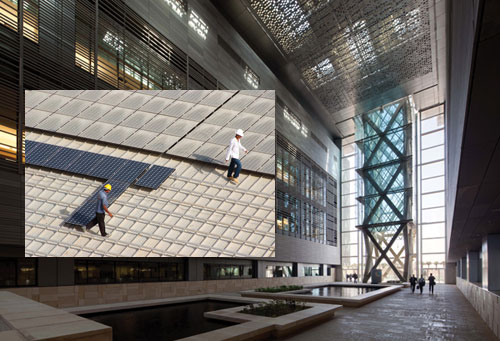 |
The King Abdullah University of Science and Technology, designed by HOK, utilizes several types of cool roofing materials. The solar performance benefits of the roofing were combined with the passive cooling strategies of vernacular design for an energy-efficient building, recognized by the U.S. Green Building Council as the world's largest LEED Platinum project.
Photo by Sam Fentress; courtesy of HOK; inset photo by JB Picoulet, courtesy of HOK |
When sunlight hits an opaque surface, some of the energy is reflected. The measured fraction of solar energy that is reflected by a roofing material's surface is called solar reflectance, or albedo. Solar reflectance is measured on a scale of 0 to 1, where the higher the solar reflectance value the "cooler" the roof. High albedo, more reflective surfaces stay much cooler than low albedo, less reflective surfaces. Energy that is not reflected by the roof is potentially absorbed by it; this is where thermal emittance comes into play.
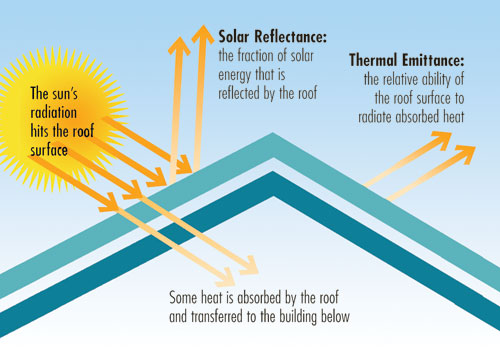 |
This diagram shows how the radiative properties of a roof affect the solar radiation hitting the surface.
Image courtesy of Cool Roof Rating Council |
Â
Thermal emittance is the relative ability for the roofing material to re-radiate absorbed heat as invisible infrared light (relative to a black body radiator). This absorbed heat will either be gradually or quickly re-radiated away from the roof; the quicker the better because the longer the heat is trapped at the surface of the roof the more likely it is to be transferred to the building below. Thermal emittance is also measured on a scale of 0 to 1, where a roofing material with a higher thermal emittance will re-emit absorbed thermal energy more quickly than a material with a low emittance and will result in a "cooler" roof.
Though most roofing materials have a fairly high thermal emittance, in order to accurately determine a roofing product's "coolness," or its ability to shield the building beneath it from heat, both solar reflectance and thermal emittance must be measured. It is possible for a roofing product to have mixed emittance and reflectance values ranging from very high to very low, although products with either a low reflectance or emittance would not typically be considered "cool" roofs. It is important to note that a high emittance value alone will not result in a "cool" roof nor will a high reflectance value alone. The Solar Reflectance Index can be a useful tool for determining the overall thermal properties of a roofing product.
Solar Reflectance Index (SRI)
Codes, standards and programs that specify cool roofing requirements may also reference an additional calculated value, the Solar Reflectance Index (SRI). SRI allows actual measured solar reflectance and thermal emittance values to be combined into a single value by determining how hot a surface would get relative to standard black and standard white surfaces. In this manner, SRI measures a material's ability to reject solar energy, based on a scale of 0 to 100.
The standard black roofing material has a high emittance value (90 percent) but a low reflectance value (5 percent). This creates a hot roof surface because even though the emittance is high, there isn't enough reflectance to prevent excessive heat gain. As such, the standard black roof is given an SRI value of 0.
The standard white roofing material is highly reflective (80 percent) and has the same emittance as the standard black surface (90 percent). Its surface is much cooler and the standard white roof is assigned an SRI value of 100. It is important to note that materials with particularly poor or good radiative properties can have a negative SRI value, or a value that exceeds 100. Like solar reflectance and thermal emittance, a higher SRI value is synonymous with a cooler roof.
Calculating SRI
Lawrence Berkeley National Laboratory (LBNL) hosts an easy-to-use SRI calculator on their website. All that is required is the solar reflectance and thermal emittance values and the tool will calculate the SRI. The calculator is located at coolcolors.lbl.gov.
Cool Roofing:
A Win-Win for Building Owners and the Environment
When properly installed and maintained, cool roofs provide numerous benefits that contribute to the health of a community, to the occupants of the building and to the owner's pocket book.
Among the benefits to the building occupants and owner are:
- Improved comfort for occupants. The building's interior is subject to less thermal flux and stays cooler during the warm season.
- Energy savings from reduced cooling energy loads.
- Longer air conditioning unit life resulting from decreased use.
- Increased roof durability due to reduced thermal flux, as cool roofs can stay up to 70 °F cooler than dark roofs.1
Cool roofs are distinguished among energy conservation measures because of the many environmental benefits they can provide. A crucial benefit of cool roofs is their ability to help mitigate the urban heat island effect. The urban heat island effect is a phenomenon that is characterized by a measured increase in the ambient air temperature in cities over their surrounding rural areas. This is due to roofs and other non-reflective surfaces that absorb and trap solar radiation-or heat. Cities can be 2° to 8°F warmer than their surrounding areas because this trapped heat gradually warms the ambient air temperature throughout the day and nighttime hours warming the urban core without any opportunity for temperatures to drop at night.2 Cool roofs help improve urban conditions by:
- Contributing to cooler ambient temperatures by immediately reflecting solar radiation back into the atmosphere before it can degrade to heat, as well as reemitting a portion of infrared light.
- Indirectly reducing air-conditioning use by lowering the ambient air temperatures.
- Improving grid stability and increasing peak energy savings by reducing the need for air-conditioning at the hottest times of the year.
Improving the Air We Breathe
Through mitigation of the urban heat island effect with the reduction of ambient air temperatures, cool roofs also improve air quality. Smog is created by photochemical reactions of air pollutants, and these reactions increase at higher temperatures. In Los Angeles alone, mitigation measures that reduce the average air temperature by 5 °F could yield a 12 percent reduction in smog (ozone) worth $360 million/year.3 Lower ambient air temperatures and the subsequent improved air quality also result in a reduction in heat-related and smog-related health issues, including heat stroke and asthma. In addition to the reduction of greenhouse gas emissions such as CO2, by conserving electricity for air conditioning cool roofs reduce the emission of nitrogen dioxide and sulfur dioxide particulates from power plants.
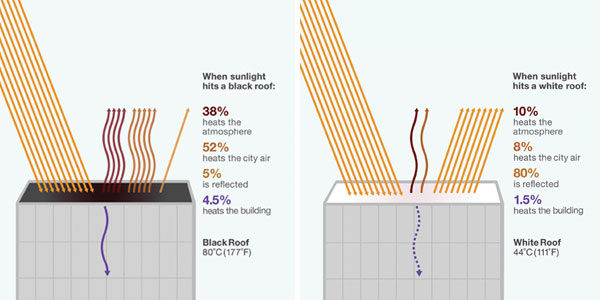 |
This diagram compares how solar radiation and heat are distributed on a black versus a white roof.
Images courtesy of Global Cool Cities Alliance Design by Imaginary Office |
Cooling Off the Planet
A LBNL study found that world-wide reflective roofing has the potential to produce a global cooling effect equivalent to offsetting 24 gigatons of CO2 over a 20 year use of the roofs. This is comparable to taking 300 million cars off the road over the same time period and equates to $600 billion in energy savings.4 The study recommends cool roofs as a geo-engineering mechanism to counteract climate change. The method by which cool roofing operates as a global cooling strategy is simple. Reflected sunlight effectively passes through the atmosphere, whereas sunlight that has been absorbed and then re-radiated from earth surfaces does not pass through easily, but is held within the atmosphere.
Quantifying Energy Savings
Research by the LBNL Heat Island Group found that buildings with lightly colored, more reflective roofs use up to 40 percent less energy for cooling than buildings with darker roofs.5 To calculate the possible savings in energy provided by a cool roof, there are two online roof calculators that estimate savings.
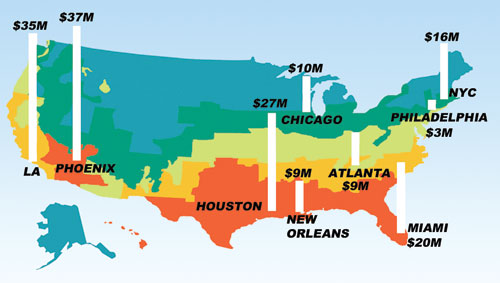 |
Nationwide implementation of cool roofs could mean an annual savings of $1 billion in cooling costs, according to a study by Lawrence Berkeley Laboratory's Heat Island Group. Values shown reflect 1997 energy prices.
Image courtesy of LBNL Heat Island Group |
Â
- The Department of Energy (DOE)Â Cool Roof Calculator was developed by the U.S. DOE's Oak Ridge National Laboratory (ORNL). This calculator provides an estimate of cooling and heating savings for small to medium sized flat-roof facilities.
- The Roof Savings Calculator was developed by LBNL and ORNL. This calculator is designed for both residential and commercial buildings using whole-building energy simulations. It allows the designer to input specific det ails about a building, including heating and cooling systems as well as location and the cost of energy.
These calculators provide a simple payback analysis to determine the possible savings in electricity or natural gas through the installation of a cool roof. As each project's savings will be unique, these calculations can provide a nuanced analysis of savings benefits.
Specifying the Perfect Roof: Product Rating Resources, Product Types, Building Programs and Codes
A cool roof should be chosen based on the slope of the roof, energy savings goals, the project location and climate, local code requirement or green building credits, as well as aesthetic preferences. Designers who are seeking sustainable design credits may also want to consider the cradle-to-cradle aspects of their materials choices, including recycled content, end of life recyclability and avoidance of toxic materials. Other sustainability considerations include the source location and weight of the product, which affect raw material use and shipping fuel, as well as the environmental impact of raw material extraction and manufacture processes.
Once the project parameters have been established, an appropriate roofing product must be selected. Several building codes, as well as voluntary green building programs, either require or allow you to achieve credits for including cool roofs in a project. Fortunately there are product rating resources available to help you specify the perfect cool roof for your project.
Product Rating Resources
Rated product databases can assist the designer in selecting an appropriate cool roof product because they list pertinent product information that can be easily compared. The designer can search roofing products by the initial and aged solar reflectance, thermal emittance, and SRI values as well as the slope application and type of roofing material. Most specifications define a low-slope roof as having a pitch less than or equal to 2:12 and a steep-sloped roof with a pitch greater than 2:12.
While existing rating systems are complementary to one another, they do have slight differences in their requirements. ENERGY STAR, for example, aims to capture the most efficient products and set minimum requirements for both initial and aged solar reflectance. In order for a product to be listed by ENERGY STAR, it must meet their minimum requirements (initial solar reflectance of 0.65 and three-year aged value of 0.50 for low-slope products and an initial reflectance of 0.25 and aged value of 0.15 for steep sloped products). The Cool Roof Rating Council (CRRC), on the other hand, does not set minimum requirements, but does require that all testing be conducted by a licensed CRRC-accredited Independent Testing Laboratory. The primary values of independent ratings for the CRRC are standardized and consistent test methods for initial and aged ratings, credible test results, a strict chain of custody, equal subjection of products to weatherization in key climates, and reliable product comparisons.
Both rating systems include aged testing, where products are exposed to natural weather conditions for a three-year period of time. The CRRC uses three specific locations representing three key climate zones (hot/dry, hot/humid, and cold/temperate) to determine aged product performance. ENERGY STAR allows aged testing to be conducted on existing roofs in place of weatherization, but also accepts products that have been rated by the CRRC so long as the ratings meet ENERGY STAR's minimum requirements for both initial and aged reflectance values. The most reliable source for solar reflectance and thermal emittance data for cool roofs is independent roofing product ratings.
Product Types
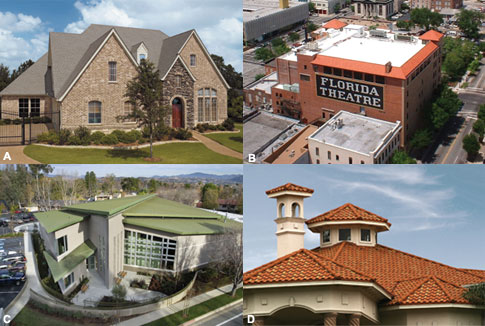 |
This composite image shows only a few of the many "cool" roofing product types that are currently available in the marketplace.
Photo A courtesy of GAF Materials Corporation, Photo B courtesy of Hydro-Stop, LLC., Photo C courtesy of Custom-Bilt Metals, Photo D courtesy of Decra Roofing. |
Â
The following is a list of common roofing materials. Once you have determined the appropriate material for your project, you can find cool roof options for most of these product types. Two useful resources to search for cool roofs by product type are the CRRC's Rated Product Directory and the ENERGY STAR Roof Product List.
- Field-Applied Roof Coatings. Field-applied coatings are applied directly onto the roof surface, either on a new roof assembly or over an existing roof surface and may require an appropriate primer. Once applied, the coating is what determines the reflective properties of the roofing product.
- Foam Roof Systems. Field-applied foam systems are sprayed on in liquid form and harden as they set on top of the roof. Factory-applied foam systems are formed into rigid panels and coated with a reflective coating in the factory. The foam usually gives the roof system additional insulation properties and the coatings provide the "cool" rating.
- Metal. Metal roofing products can be shaped to look like shingles or shakes, or to fit unique curvatures, in addition to a typical standing seam configuration. They come in a variety of factory-applied textures and colors, including darker "cool" colors with infrared reflective pigments. Metal products can also be coated in "cool" custom colors to meet a variety of client preferences.
- Modified Bitumen and Built-Up Roofing. Modified bitumen is bitumen (asphalt or tar) modified with plastic and layered with reinforcing materials then topped with a surfacing material. Built-up roofing (BUR) consists of built-up layers of coated asphalt and insulation applied on site and can be covered with a capsheet or field-applied coating (surfacing materials). The "cool" part of these roof products refers to the reflective properties of the capsheet, top coating or surface granules.
- Shingles. These roofing products are commonly used for residential or steeper-sloped buildings, including some commercial buildings. For "cool" colored shingles, the heightene d solar reflectance comes from granules that contain solar-reflective pigments.
- Single-ply. Single-ply roofing is a pre-fabricated sheet of rubber polymers. Single-ply roofing is laid down in a single layer over a roof. The single-ply membrane can be firmly set on the roof and attached with mechanical fasteners or adhesives. There are two main types of single-ply materials: single-ply thermoset and single-ply thermoplastic. These roofing products can be specified with an ultra-violet-resistant and highly reflective surface.
- Synthetic Polymer Composite Products. These polymer injection molded roofing products can be shaped into any form, often to look like wood shakes, tile or slate roofing products. "Cool" composite products are selected by color, or may have cool reflective pigment colorants built into the polymer formula. Some composite products are additionally sustainable are more sustainable if they are made from recycled materials or can be recycled after full-life use.
- Tile or Pavers. Tile products (clay or concrete) are available with solar-reflective surfaces that increase the number of "cool" colors from which the designer can choose. Additionally, the dense, earthen composition of tile products provides increased thermal mass and ventilation properties, which yield additional energy savings that are not captured through solar reflectance and thermal emittance measurements.
Solar and Green Roofs
Cool roofs can be designed to complement other sustainable roof systems allowing designers to maximize their roof options by combining green roofs and solar collection systems with cool roofs. Each sustainable system offers unique benefits and although green roofs and solar collection systems are not considered cool roofs, their benefits can be enhanced with a cool roof.
Green roofs or "living roofs" use plants as the roof covering. While green roofs have many benefits such as providing habitat, increasing roof lifespan, and reducing storm water runoff, they do not have high reflectance, a key feature of cool roofs. If you are specifying a green roof, consider using cool pavers for the pathways and using a cool roof on the non-green roof regions. Cool pavers act similarly to cool tile roofs, helping maintain a cool surface and ambient air temperatures that create a more pleasant environment for occupants and plants.
Several studies are currently being conducted on the interplay between cool roof coatings and solar photovoltaic systems. Because cool roofs can keep the roof surface 70 °F cooler than dark roofs, cool roofs may maintain solar photovoltaic and solar thermal systems at optimal temperatures, improving both performance and lifespan of the systems.1 Some solar photovoltaic systems are even designed with curved surfaces to capture solar radiation reflected off the cool roof surface.
Cool Roof Advocacy |
Governments and organizations around the country have been promoting the benefits of cool roofs by creating incentives and cool roof outreach programs:
NYC °CoolRoofs is a collaborative project of NYC Service and the NYC Department of Buildings. The initiative was designed to bring together building owners and volunteers to retrofit their roofs. NYC °CoolRoofs exceeded its 2010 goal of coating one million square feet of roofing, and plans to continue the program in upcoming years.
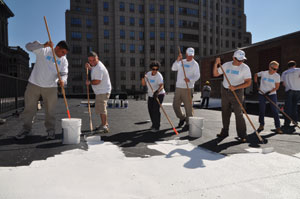 Global Cool Cities Alliance focuses on cool roof and pavement outreach. The organization recruits cities worldwide to adopt cool surface policies and codes for widespread installation by 2020. Global Cool Cities Alliance provides financial mechanisms, for example research support, to facilitate their cool surface adoption goals. Global Cool Cities Alliance focuses on cool roof and pavement outreach. The organization recruits cities worldwide to adopt cool surface policies and codes for widespread installation by 2020. Global Cool Cities Alliance provides financial mechanisms, for example research support, to facilitate their cool surface adoption goals.
As more and more people learn about cool roofs and surfaces, we can realize the benefits of cool roofs on not only a personal level, but collectively to cool our neighborhoods and urban centers. |
Volunteers participating in the NYC °Cool Roofs Program paint an urban rooftop with a cool roof coating.
Photo by of Samantha Modell |
Â
Comprehensive Design with a Cool Roof
Smart designers consider the pros and cons of a variety of sustainable design features for one project. A combination of energy efficient and energy generating design features can be used in passive solar design. You may choose to specify a cool roof coating and solar photovoltaic panels on the south side of the building to capitalize on the higher solar exposure. Tall plants on a green roof may be used to shade windows oriented west from high solar gain, or to distract from an unpleasant view. If your project has a tight budget, the vast array of cool roof options allows you to specify a cool roof for areas of the building that receive high solar radiation, such as the south and west sides of a pitched roof, while saving money on a visually similar, yet not cool product for the northern side. When designing your next project, consider integrating multiple roofing products or technologies to take advantage of their distinctive benefits.
Aging and Maintenance
Solar reflectance and thermal emittance are surface properties. The "coolness" of a roof is therefore dependent on the surface condition of roofing products, which must withstand years of harsh climates, solar radiation, pollutants and algae growth. ORNL studied the three-year aging and weathering of cool roofing membranes made of single-ply roofing at various locations across the United States.6 Results indicated that when washed with detergent, the majority of the roofs will still provide 90 percent of their un-weathered reflectance (in some cases an algaecide was required). Standard maintenance practices as suggested by the roofing manufacturer will keep your cool roof "cool" for a longer period.
Building Programs and Codes
(Please note: this section was current at the date of publication. Please check with the individual code body or program for updates.)
Cool Roofs are Going Global
Increased recognition of the benefits of cool roofing has led to the adoption of cool roof measures in energy codes and the inclusion of cool roofing as part of green building initiatives across the country. Yet the outreach of organizations such as the Global Cool Cities Alliance (see case study) has expanded the discussion to a global audience, with several governments from Delhi to Montreal exploring cool roof policies. The European Union has formed the EU Cool Roof Council to promote cool roof awareness across Europe. The U.S. DOE has taken a lead by supporting cool roofs outreach to rapidly developing countries such as China and India, where the energy performance benefits can have substantial impacts on national energy consumption. Highlighted below is a cross-section of progressive programs and standards in use today, on the national, state and city levels.
Voluntary Green Building Programs
LEED®
The U.S. Green Building Council's LEED program provides certification for the energy and environmental design in the planning and construction of a building. From North Dakota to North Carolina architects are planning LEED buildings that can attain silver, gold or even platinum certification. The LEED program includes a credit for cool roofs under the Sustainable Sites category in recognition of the importance of urban heat island reduction, where to meet LEED Credit 7.2 a cool roof must have a minimum SRI of 78 for low sloped roofs and 29 for steep sloped roofs.
Green Globesâ„¢
The Green Building Initiative's Green Globesâ„¢ program is a green management tool that includes an assessment protocol and a rating system and guide for integrating environmentally friendly design into both new and existing commercial buildings. Green Globes provides credit for cool roofs as a component of their rating system, where the minimum SRI requirements are equivalent to LEED's standards.
Energy Codes
ASHRAE
National energy codes developed by the American Society of Heating, Refrigerating and Air-Conditioning Engineers (ASHRAE) are not mandatory regulations unless adopted by a jurisdiction as part of a regulation or law. Many states and cities have adopted either the ASHRAE or International Code Council codes or have adopted their own building codes. ASHRAE standards allow designers to reduce roof insulation when a cool roof surfacing material is used on the roof. ASHRAE 90.1, the Energy Standard for Buildings Except Low-rise Residential Buildings, section 5.3.1.1, defines cool roofs as having a minimum solar reflectance of 0.70 and a minimum thermal emittance of 0.75. The 2007 version of ASHRAE 90.1 adds an alternative of achieving a minimum SRI of 82. ASHRAE 90.1 only credits cool roofs in climate zones one, two and three, based on the DOE climate zones map.7 ASHRAE also produces an Advanced Energy Design Guide for Small Office Buildings and an Advanced Energy Design Guide for Small Retail. These guides provide suggestions for achieving greater energy savings than standard 90.1 and include the use of cool roofs.
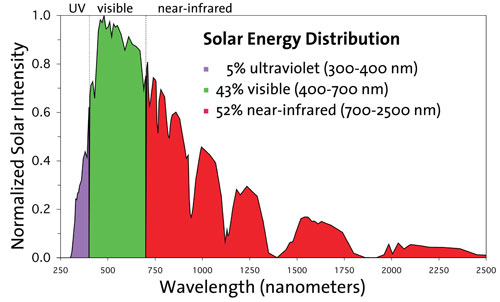 |
Solar energy distribution graph illustrating that infrared radiation makes up a large portion of the solar spectrum.
Graph courtesy of LBNL Heat Island Group. |
Â

IECC & IGCC
The International Energy Conservation Code (IECC) provided by the International Code Council contains both prescriptive and performance measures for energy savings and references ASHRAE 90.1 in defining acceptable performance levels for cool roofs. The International Green Construction Code (IgCC) is a model energy code for commercial green building that can be modified and adopted worldwide. The IgCC specified a low sloped cool roof as a roof covering with a minimum aged solar reflectance of 0.55 and a minimum aged thermal emittance of 0.75, or a minimum aged SRI of 60. It defines a steep sloped cool roof as a roof covering with a minimum aged solar reflectance of 0.30 and a minimum aged thermal emittance of 0.75, or a minimum aged SRI of 25.
California − Title 24
Although cool roofs are not a mandatory measure for California's Building Energy Efficiency Code, Title 24, these regulations outline a clear prescription for the use of a cool roof as part of a building envelope. Under Title 24, if a cool roof is not used in situations where it is prescribed, the energy savings must be made up in another way, such as insulation with a higher thermal resistance (R-value), or windows with a lower thermal conductance (U-value), etc. Title 24 promotes energy efficiency by outlining energy standards and requiring compliance to a strict energy code. The code recognizes that cool roof surfaces can save 15 percent of the electricity needed to cool a building and that cool roofs reduce urban heat island effect causing an improvement in air quality.
A cool roof must be installed as part of prescriptive compliance to the code, or an allowed tradeoff among the building envelope components may be substituted. The performance method allows for the cool roof to set the energy budget for the proposed building. There are qualifications for conditioned and unconditioned spaces, but the main thrust of the regulations is that roof materials must obtain a third-party product rating by the CRRC, must be properly labeled and meet the minimum specified reflectance and emittance values set by the code.8 As of August 2009, Title 24 defines unique solar reflectance, thermal emittance, and SRI values based on the climate zone, slope, roofing material, and nature of the project. Generally, Title 24 cool roof requirements are as follows:
City of Chicago
The City of Chicago is one of many cities who have begun to mandate cool roofs as a way to mitigate the urban heat island effect. The Energy Conservation Code requires that new residential and commercial low-slope roofs have a minimum initial solar reflectance value of 0.72 or a three-year aged value of 0.50. New medium slope roofs (2:12 to 5:12) are required to have a minimum initial reflectance value of 0.15. Steep slope roofs (greater than 5:12), are exempt from any initial reflectance requirements. All roofing products must be rated by the CRRC or by ENERGY STAR.9
Rebates and Tax Credits
Because of the importance of reducing our carbon footprint and dependence on fossil fuels, there are numerous rebate programs and tax credits offered for energy efficiency measures, including cool roofing. Lists of rebate programs can be found online, as well as through local utility companies and the California Energy Commission. 9,10
The Many Faces of Cool Roofs: Dispelling Preconceived Notions of Cool Roofs
In the past, it was a common misconception that cool roofs only applied to flat, white surfaces, and were not appropriate where aesthetics were a concern. Others believed that cool roofs were much more expensive than standard roofs, and could only attain energy saving in hot climates. Today, these myths have been dispelled with the wealth of material and color options made possible by research and material technology advancement.
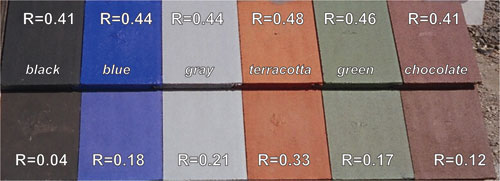 |
Advancements in pigment technology increase solar reflectance across a broad spectrum.
Photo courtesy of American Rooftile Coatings. |
Â
Researchers have created a new pallet of roofing materials that combine the properties of color with reflective surface materials that challenge some of the basic assumptions of what constitutes a cool roof. Numerous roofing materials are now rated with relatively high reflectance and emittance values, including high profile products, colored products and those applicable for steep sloped roofs. These products allow designers to realize the energy performance benefits of cool roofs without sacrificing design aesthetics.
Color is made visible by light reflecting off a surface and into our eyes; however, sunlight has other properties that extend beyond the visible portion we can see. We have an intuitive understanding of the power of certain colors to reflect light as well as absorb heat, e.g., black leather seats in a convertible will be uncomfortably hot in the summer, and white clothing is a cooler choice at the beach. However, sunlight is composed of infrared and ultraviolet radiation, as well as the visible wavelengths (shown in graph above). In fact, about half of the sun's energy is infrared. "Cool color" roofing materials are created by integrating pigments that reflect infrared energy, even though their color may still absorb some of the visible spectrum. In this way, roofing products can be both "cool" and dark colored. This type of infrared reflective pigment has been used in conjunction with a variety of product types, including metal, tile, coatings and asphalt shingle granules, thus broadening the scope of cool roof applicability.
A research project by LBNL assisted manufacturers with developing new colors for cool roofing materials.11 These new "cool color" products demonstrate that cool roofs don't always have to be white in order to reap the benefits of an energy-efficient roof. While the energy savings of a "cool" rustic red roof will not be equivalent to that of a white or lighter colored roof, it will certainly deliver more energy savings than its traditional non-cool rustic red counterpart; this is the power of infrared reflective pigments.
The Southwest Energy Efficiency Project (SWEEP) |
The Southwest Energy Efficiency Project (SWEEP) is a multi-state organization promoting energy efficiency primarily in the Southwest. SWEEP conducted a regional case study using the cool roof at the Thomas O. Price Service Center in Tucson, Arizona. This project highlights a retrofit of an existing 23,400 sq. ft office building. As part of the "Creating Cool" campaign, a cool roof was installed on Building One in order to offset the urban heat island effect.
The existing 28,000 sq.ft. aluminum roof included portions of a darker, blackened copper surface. The roof was retrofitted with a white elastomeric top coating in June 2001. The peak temperature reduction between the black roof and the cool roof was an average of 78 °F and between the raw metal roof and the cool roof surface, 46 °F. The average temperature reductions were between 17 °F and 10 °F between the black/metal roof and the cool roof surface. The building demonstrated a reduction in energy consumption of almost 50 percent with the cool roof, primarily due to a decrease in energy used for air conditioning.
The payback period for this investment in 2001 was approximately six years and the rate of return was 16 percent for the investment. The new roof had the added benefits of repairing existing roof leaks and extending the life of the roof from a UV-resistant coating that provided increased protection from solar radiation. |
Â
Price Comparison
As with any green product, a popular belief is that cool roof products are prohibitively more expensive than traditional roofs, such that the energy cost savings will never make up for the initial costs. Cool roof benefits can be realized simply by making smart color choices. A designer may choose a light grey coated metal panel rather than a dark grey, which can keep the building cooler without any additional costs. However, a cool roof need not cost more than a non-cool roof, and certain product types can be similar in cost to the conventional non-cool style. While some cool roof materials are more expensive than their non-cool counterparts, prices are decreasing as cool roofing becomes a more widely used option. Cool roof incentives and rebates can also help offset additional costs. Utilize the calculators mentioned in the "Quantifying Energy Savings" section to assist in calculating payback options.
In July 2010, the DOE released Guidelines for Selecting Cool Roofs, as part of their effort to broadly implement cool roofing technologies in the Federal Government. This resource provides an in-depth study of the economics of cool roofing.
Cool Roofs in Cool Climates
Another myth that hounds cool roofs is the notion that they should not be used in cold climates. However, there are several factors that can make cooling energy savings outweigh heating penalties in climates with cold weather. The sun is lower in the sky in the winter than in it is in the summer; the further north one goes, the lower it gets. Because of the shallow incoming angle, solar rays have to travel through a thicker cross-section of atmosphere during winter. As a result, the diffuse rays lose some of their potency. Additional factors that reduce the potential for heat gain during winter are that the days are shorter and there are fewer sunny days. It is also fairly typical to see snow-covered roofs in climates where a heating penalty might be a concern; this condition obviously negates any effect a roof's reflectivity may have on heat loss or gain.
While more energy can be saved through the use of cool roofs in hot climates than in cold climates, there can still be advantages to specifying cool roofs in cooler climates, especially where significant air-conditioning is needed in hot summer months. In addition, it has become increasingly evident that urban heat islands exist in cool climates, and the summertime benefits of installing a cool roof may outweigh the heating penalties during winter. It is important to remember that the majority of the cooler indoor temperature and energy savings from cool roofs are realized in the spaces immediately below the roof, and may be lessened in buildings with substantial insulation. The energy savings calculators developed by DOE and EPA are great tools to help assess the effectiveness of a cool roof in any climate.
What's Next in Cool Roofing
We have seen major breakthroughs in cool roof technology in the past decade. Formula improvements such as light reflective pigments have extended cool roofs to include colored and steep sloped products. The scope of research is not only improving existing product types, but changing the way product samples are rated, and exploring new product types that redefine the roof and its interaction with solar radiation and weathering in a whole new way.
Sustainable Design Research Laboratory, Ann Arbor, MI |
In 2006, A3C Collaborative Architecture decided to convert their offices into a learning lab for numerous environmental systems and products and created the urbEn Retreat, a rooftop meeting space that overlooks a demonstration cool and green roof.
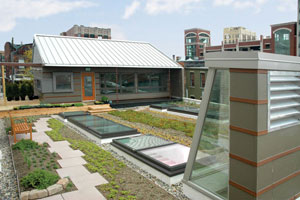 The project covers several thermal studies of cool roof performance in southeast Michigan. While several studies have been done of other areas of the country, none have factored in the lake effect and weather conditions of Lower Michigan, where there tend to be only three days of clear sky during December, January and February. The weather can typically be described as cold, dark, grey and snowy. A3C is working with the University of Michigan Architecture School's Sustainable Design Lab to assess the performance of cool roofs over a full year. While results are not yet fully compiled, the initial returns show that cool roofs provide a benefit to building owners in the region by reducing rooftop thermal gain during the summer. The project covers several thermal studies of cool roof performance in southeast Michigan. While several studies have been done of other areas of the country, none have factored in the lake effect and weather conditions of Lower Michigan, where there tend to be only three days of clear sky during December, January and February. The weather can typically be described as cold, dark, grey and snowy. A3C is working with the University of Michigan Architecture School's Sustainable Design Lab to assess the performance of cool roofs over a full year. While results are not yet fully compiled, the initial returns show that cool roofs provide a benefit to building owners in the region by reducing rooftop thermal gain during the summer.
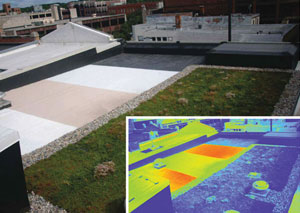 Measurements from the first day of summer and the hottest day of summer show that the white membrane cool roof provides an 80 percent reduction in heat transfer through the roof as compared to the black EPDM roof, providing a substantial benefit to the building owner. Data for the spring and fall months indicates that there is no heating penalty, or heat loss through the roof, that can be directly attributed to the cool roof. Similarly, when the roof is covered with snow during the winter months, the data indicates that there is a negligible and equal heat loss through the cool and non-cool roof surfaces. Measurements from this study show that cool roofs can not only be effective in cool climates, but are also applicable for both sloped and flat surface configurations. Measurements from the first day of summer and the hottest day of summer show that the white membrane cool roof provides an 80 percent reduction in heat transfer through the roof as compared to the black EPDM roof, providing a substantial benefit to the building owner. Data for the spring and fall months indicates that there is no heating penalty, or heat loss through the roof, that can be directly attributed to the cool roof. Similarly, when the roof is covered with snow during the winter months, the data indicates that there is a negligible and equal heat loss through the cool and non-cool roof surfaces. Measurements from this study show that cool roofs can not only be effective in cool climates, but are also applicable for both sloped and flat surface configurations.
This thermal image illustrates the reflected solar radiation from three different cool roof surfaces on an Ann Arbor, MI rooftop. The two roof segments that appear bright orange correspond to the two most reflective products and the bright yellow segments to the somewhat less reflective product. The dark purple areas indicate the non-cool portions of the roof (or the least reflective surfaces).
Photos courtesy of A3C Collaborative Architecture. |
Â
The LBNL Heat Island Group is developing a method to accelerate the aging process for aged testing. Currently both the CRRC Product Rating Program and ENERGY STAR require products to be tested after three years of weathering to gauge the performance of products over their lifespan. Accelerated aging would mimic the weathering process in a span of a few months rather than years, allowing the industry to evolve product formulas as fast as manufacturers can test them. The Heat Island Group is also exploring a self-cleaning surface, which would help products maintain their solar performance over time. This could have significant impact on the required maintenance of a roof, as well as the roof's durability.
While cool roofs have been an easy, passive energy efficiency strategy, new research is redefining the function of a roof. As mentioned above, in the "Solar and Green Roofs" section, manufacturers are investigating how to marry the energy generation benefits of solar systems with the reflective properties of a cool roof. New innovative technology continues to burst on the market, including a recycled cooking oil roof coating that can sense temperature changes and either reflect or absorb solar radiation based on preset temperature thresholds unique to that building and climate and holographic materials that reflect light that shines down from the sky yet look dark colored to those viewing the roof from below.12
With increasingly rigorous roofing code and standards, and promising technologies on the horizon, cool roofs are quickly becoming one of the most effective ways to obtain significant energy savings and environmental rewards. Cool roofs can be the simplest design measure to implement, in both new construction and existing buildings, without compromising project design or performance. Whether a project incorporates cool roof emerging technology or utilizes standard reflective processes, a designer specifying a rooftop now has several resources available to make informed and confident cool roof choices.
LEED Project-The King Abdullah University of Science and Technology-HOK |
The design firm of Hellmuth, Obata and Kassabaum (HOK) designed the King Abdullah University of Science and Technology to be the first LEED certified project in the Kingdom of Saudi Arabia. It is also the largest LEED Platinum project in the world. The project features a 90,000 square foot cool roof combining the following materials:
- White Ethylene Propylene Diene Monomer (EPDM) with an SRI of 84
- Coated Metal with an SRI of 82
- Galvanized Steel with an SRI of 46
- Light Gravel with an SRI of 37
The project takes design cues from traditional Arabic architectural features developed in response to the harsh climate. These passive design strategies include a shading system that mimics traditional latticework screens called mashrabiya, natural ventilation through solar chimneys, and a compact, staggered building plan that allows building sections to shade each other. These features complement and magnify the cooling effects of the roof.13
Similar to the vernacular design strategies used on the University, cool roofs are not a new idea, being employed around history throughout the world from Greece to Bermuda. |
Â
Â
|
| The Cool Roof Rating Council is a non-profit organization that maintains a credible, third-party rating program for measuring and labeling the radiative properties of roofing products. The Council publishes these ratings via its online directory as a public service for use by architects, code officials, building owners and other interested parties.
www.coolroofs.org. |
|






 Global Cool Cities Alliance focuses on cool roof and pavement outreach. The organization recruits cities worldwide to adopt cool surface policies and codes for widespread installation by 2020. Global Cool Cities Alliance provides financial mechanisms, for example research support, to facilitate their cool surface adoption goals.
Global Cool Cities Alliance focuses on cool roof and pavement outreach. The organization recruits cities worldwide to adopt cool surface policies and codes for widespread installation by 2020. Global Cool Cities Alliance provides financial mechanisms, for example research support, to facilitate their cool surface adoption goals.


 The project covers several thermal studies of cool roof performance in southeast Michigan. While several studies have been done of other areas of the country, none have factored in the lake effect and weather conditions of Lower Michigan, where there tend to be only three days of clear sky during December, January and February. The weather can typically be described as cold, dark, grey and snowy. A3C is working with the University of Michigan Architecture School's Sustainable Design Lab to assess the performance of cool roofs over a full year. While results are not yet fully compiled, the initial returns show that cool roofs provide a benefit to building owners in the region by reducing rooftop thermal gain during the summer.
The project covers several thermal studies of cool roof performance in southeast Michigan. While several studies have been done of other areas of the country, none have factored in the lake effect and weather conditions of Lower Michigan, where there tend to be only three days of clear sky during December, January and February. The weather can typically be described as cold, dark, grey and snowy. A3C is working with the University of Michigan Architecture School's Sustainable Design Lab to assess the performance of cool roofs over a full year. While results are not yet fully compiled, the initial returns show that cool roofs provide a benefit to building owners in the region by reducing rooftop thermal gain during the summer. Measurements from the first day of summer and the hottest day of summer show that the white membrane cool roof provides an 80 percent reduction in heat transfer through the roof as compared to the black EPDM roof, providing a substantial benefit to the building owner. Data for the spring and fall months indicates that there is no heating penalty, or heat loss through the roof, that can be directly attributed to the cool roof. Similarly, when the roof is covered with snow during the winter months, the data indicates that there is a negligible and equal heat loss through the cool and non-cool roof surfaces. Measurements from this study show that cool roofs can not only be effective in cool climates, but are also applicable for both sloped and flat surface configurations.
Measurements from the first day of summer and the hottest day of summer show that the white membrane cool roof provides an 80 percent reduction in heat transfer through the roof as compared to the black EPDM roof, providing a substantial benefit to the building owner. Data for the spring and fall months indicates that there is no heating penalty, or heat loss through the roof, that can be directly attributed to the cool roof. Similarly, when the roof is covered with snow during the winter months, the data indicates that there is a negligible and equal heat loss through the cool and non-cool roof surfaces. Measurements from this study show that cool roofs can not only be effective in cool climates, but are also applicable for both sloped and flat surface configurations.